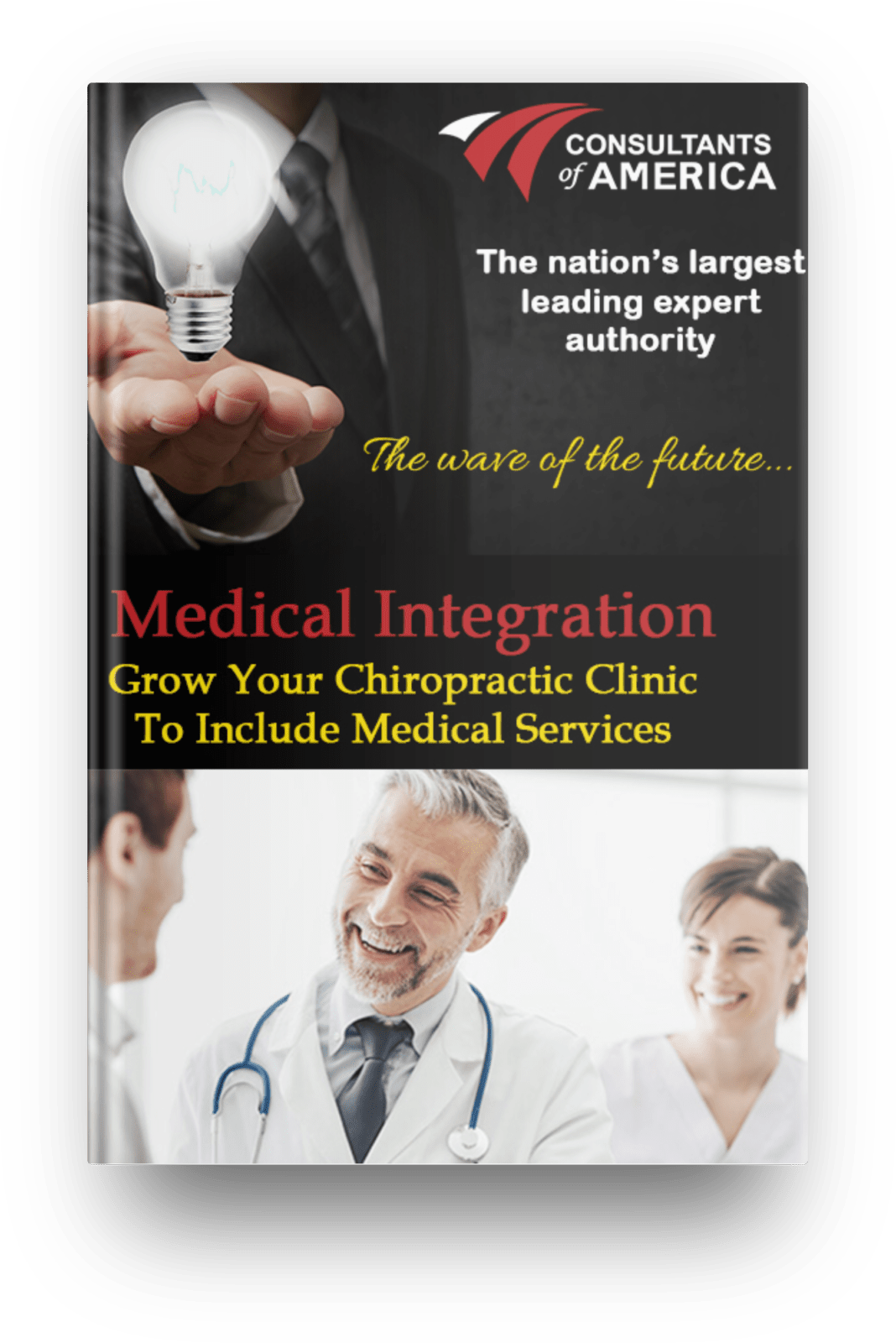The Integrated Medical Center the Wave of The Future
The Integrated Medical Center
What is an integrated medical center (IMC)? What does it do? How does it compete in today’s health care arena? Is it legal? How many different names are used to describe the same center? Is an integrated medical center created to circumvent limits on chiropractic benefits?
“Basically, what is the whole story”?
This article is designed to give you a comprehensive understanding and complete overview of what, how, when, and why integrated medical clinics have made so much of the news reporting the last several years.
Definition: An integrated medical center is a practice made up of at least two (2) healthcare professionals of different disciplines practicing in the same location.
How are they generally referred to in the field?
Integrated Medical Center, a MultiDiscipline Center (MDC), a holistic health care center, a one-stop shop, a complimentary healthcare facility, a comprehensive facility, or simply DC/MD center etc.…
Who are these healthcare practitioners?
From a Chiropractic point of view, it is a joining of a DC and an MD (or DO and or NP) to co-treat patients.
How have these INTEGRATED MEDICAL CENTER’s evolved?
Integrated medical centers have existed for decades. However, most DC’s only started looking into such ventures en masse since 1994 when I first became a consultant. Indeed, about 83 million people in the US (42% of the adult population) used at least one alternative therapy in 1997. Usage among those age 35-49 is even higher at 50%. The estimated number of visits in “97” to providers of “unconventional therapy” (629 million) was greater than the number of visits to all primary care medical doctors nationwide (386 million).
Americans spent $21 billion out of pocket on visits to alternative practitioners in “97 (an increase of 45% versus 1990). This does not include money spent on retail products, such as herbal products ($5.1 billion), books, classes and equipment (4.7 billion). For comparison, out of pocket expenditures for physician visits was $29.3 billion and for hospitalizations was $9.1 billion).
We have to ask why 42.1 percent of U.S. citizens surveyed used at least one of 16 alternative medicine practitioners increase from 427 million in 1990 to 629 million in 1997, exceeding the total visits to primary care physicians? These are in the staggering numbers.
As reported in the New York Times article, in June 2016, Americans spend $30.2 billion a year on alternative and complementary medicines and procedures, including $1.9 billion on children 4 to 17 years old. None of it is covered by insurance.
The National Center for Health Statistics, which maintains a continuing health survey of Americans, concludes that in 2012, 55.2 million adults and 4.1 million children had at least one expenditure for some kind of complementary health care.
Almost half the money — $14.7 billion — was spent visiting practitioners like acupuncturists, homeopaths, naturopaths, Chelation therapists, mind-body experts, energy healing specialists, hypnotists, massage therapists and traditional healers.
Natural product supplements (excluding vitamin and mineral diet supplements) cost $12.8 billion, and $2.7 billion was paid for self-care, including expenses for books and educational materials on diet-based therapies, guided imagery, meditation, Tai chi, movement therapies, biofeedback and other treatments.
In a sense, $30.2 billion is not much money — only 1.1 percent of the nation’s total health care bill, $2.82 trillion. But the $12.8 billion spent on natural product supplements is 24 percent of the $54 billion spent out of pocket on prescription drugs, and the $14.7 billion in visits to alternative practitioners is almost a third of the out-of-pocket expenditures for visits to conventional physicians.
“The reason we like looking at cost data is because cost tells you how much people value these approaches,” said the lead author of the report, Richard L. Nahin, an epidemiologist with the National Institutes of Health.
“Someone may use a therapy when it’s free, and then not when they have to pay for it. But when people say they’re willing to pay out of pocket for alternative treatment, they really must value and believe in it.”
Unsurprisingly, the average expenditure for a family increased with income. Families with incomes less than $25,000 spent an average of $435 a year on alternative care, and those with incomes exceeding $100,000 averaged $590.
The above statistics also clearly show that the intent of interest of alternative therapy from the public has definitely increased. It is interesting to note also that another reason why the medical integration has become so popular is for its financial rewards. Indeed, as insurance companies contracted with more and more HMO’s, doctors found themselves rendering the same type of service with decreased reimbursements. Most doctors, therefore, started to look for different venues to supplement their income.
Another reason is that the general population wants results (i.e. Here and Now!!). The consumers demand that service be rendered expeditiously (Internet, cable…) and conveniently (Cell phones, pagers…).
It is interesting to note, however, that there are more integrated medical clinics in California, Illinois, New York, and Florida. Other states where managed care has very little (if any) affect have tried to create these integrated medical centers at a smaller scale. Indeed, Consultant of America (COA) the nation’s largest medical integration consulting and management firm with over 1256 offices in 45 states has kept extensive records regarding the demographics about the nations integrated medical centers. By far, New York and Florida are at the top of this list for medical integration.
Hence, an integrated medical center offers in one location a great variety of diversified services to treat many conditions.
What are the requirements in starting an INTEGRATED MEDICAL CENTER?
My 26 plus years of experience as a consultant have confirmed that to truly succeed, the minimum requirement for an integrated medical center practice is to have at least 125-office visits per week, 20-25 new patients per month, and about $25,000 or more per month in collection. Also, the clinic should have been established at least for 3 years. The minimum square footage is about 800 sq. ft. Lastly, a working capital of at least $15,000 is needed for the first 90 days of inception. The doctor needs to have a “clean record” (i.e. no restriction with licensure, FBI file, state suit, etc.) As a matter a fact, Consultants of America will review each potential applicant before considering their membership.
Contrary to popular belief, an extensive knowledge of medical coding is not an absolute necessity. What is of greater importance is a well-trained management team to be able to help with the step by step protocols.
What about legalities?
Having assisted to establish over 1256 integrated medical centers in 45 states for over 25 years and having practiced personally in my own fully integrated centers for close to 10 years, I unequivocally recommend that it is critical that each doctor interested in medical integration only considers working with qualified health care legal representation. Given the fact that there have been many investigations with integrated medical centers, why would anyone take such a chance and not act prudently.
Personally, as a past expert witness from the prosecution side, I have learned that the various regulatory bodies who get involved in such cases spend a considerable amount of money and efforts to eliminate anyone trying to circumvent the rules.
Following are suggestions to review with your potential attorney:
- Is the legal firm specifically and/or exclusively “a health law group”?
- How many integrated medical centers have they established and how long ago?
- Are they aware of the latest health rules and regulations?
- Can they provide you with several references of current successful operating centers?
- Are they endorsed by your state Chiropractic association (local and/or state level)
What are the pros and cons of an INTEGRATED MEDICAL CENTER?
Pros:
- One Stop Shop-The patient, the most important asset of your practice, receives comprehensive care.
- Every Patient Benefits – In an integrated medical center, patients with all types of healthcare conditions will be treated (e.g. medication refill, cholesterol checkup, general physical exams, etc.)
- Limited Insurance Coverage-A fully accredited medical center with multiple providers can be part of many various plans.
- Greater Financial Reward– Across the country as a generally accepted established protocol, the medical fee schedule is higher in billing, better in reimbursement, faster in payment and much easier in collections.
- Patients Are More Comfortable– Over 80% of the whole population has been and continues to be seen by medical doctors. Operating in an integrated medical clinic will make you part of the widest and most prevalent healthcare system while keeping your philosophy intact.
- HMO’s, PPO’s, and IPA’s-The managed care arena is set up to minimize expenses while improving the efficiency of its health care delivery system. In an integrated medical center, several qualified health care providers working together offer what the future is demanding.
- Patient Retention-Because society has been so “ingrained” in believing that medicine maybe “the only” answer to all health issues, MD’s, DC’s, and PT’s working together will prove that there are many alternative treatments for the same condition.
- Liability-Multiple specialists working together in one setting have a greater understanding of patients’ needs and conditions and therefore can minimize liabilities.
- Competition-Our generation of patients expect only the “best of all worlds,” efficiency, timing, and savings… An integrated medical center can deliver the most unadulterated genuine care available.
- Growth-Your center can offer many services:
- Medical: general medicine, neurology, physiatrist, orthopedic care…
- Musculoskeletal: chiropractic, physiotherapy, massage therapy…
- Rehabilitation: physical therapy, physical medicine, occupational therapy…
- Diagnostics: EMG, NCV, EEG, SSEP, SEMG…
- Ancillary services: blood work, durable medical equipment, in-office testing…
- Patient services: hospital privileges, emergencies…
- Out-patient: medical referral, medical network…
- Workers Compensation (W/C)-Employers, adjusters and patients searching for efficient, thorough, diversified care will find the integrated medical center a viable solution.
Cons:
- Philosophy– If the DC is not well “anchored” in his/her chiropractic philosophy, the center can lose its identity and become “another medical” clinic with limited Chiropractic care.
- Treatment Protocols– Relevant condition issues will need to be discussed between MD’s and DC’s until both professionals are comfortable with each other’s approach and treatment protocols possibly causing scheduling delays.
- Personality-Bringing various health care providers under one roof, if not properly established, can cause misunderstanding.
- Expenses– Medical integration will initially cause an increase in legal, consulting, billing staff, management time, MD/NP salaries, etc.
- Marketing—At the introductory stage, promoting the new integrated medical center will add marketing expenses.
- Reputation– Some colleagues, and relatives may think that the chiropractor by integrating the clinic, has “abandoned” the true chiropractic philosophy.
- Confusion-During the initial transitional stage, if not properly instituted, patients may experience some scheduling confusion.
- Liability-If the integrated medical center is launched without a well-trained managerial team, it can jeopardize the viability of any future growth.




